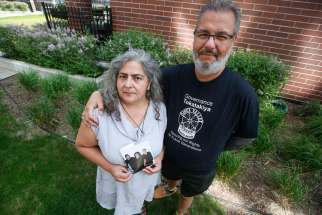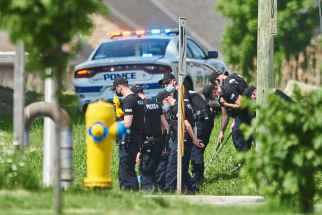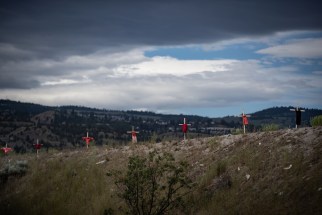Painful history lesson Canadians need to learn
Read this article for free:
or
Already have an account? Log in here »
To continue reading, please subscribe:
Monthly Digital Subscription
$0 for the first 4 weeks*
- Enjoy unlimited reading on winnipegfreepress.com
- Read the E-Edition, our digital replica newspaper
- Access News Break, our award-winning app
- Play interactive puzzles
*No charge for 4 weeks then price increases to the regular rate of $19.00 plus GST every four weeks. Offer available to new and qualified returning subscribers only. Cancel any time.
Monthly Digital Subscription
$4.75/week*
- Enjoy unlimited reading on winnipegfreepress.com
- Read the E-Edition, our digital replica newspaper
- Access News Break, our award-winning app
- Play interactive puzzles
*Billed as $19 plus GST every four weeks. Cancel any time.
To continue reading, please subscribe:
Add Free Press access to your Brandon Sun subscription for only an additional
$1 for the first 4 weeks*
*Your next subscription payment will increase by $1.00 and you will be charged $16.99 plus GST for four weeks. After four weeks, your payment will increase to $23.99 plus GST every four weeks.
Read unlimited articles for free today:
or
Already have an account? Log in here »
Hey there, time traveller!
This article was published 07/06/2021 (1650 days ago), so information in it may no longer be current.
Philippe Casgrain, a Quebec Liberal MP, told the House of Commons in 1883 he believed it was just a matter of time before Canada’s Indigenous people would become extinct.
“Indians of the North-West Territory, they are a doomed race, and it is only a question of how soon they will disappear,” said Casgrain, during a Commons debate on Department of Indian Affairs expenditures.
Casgrain described what he believed was an “inaptitude of the Indians to enter into civilized life.” He predicted government’s attempt to assimilate First Nations into white, Christian society would ultimately lead to their disappearance as a people.

“The experiment has been tried ever since the beginning of the colony, and I know of only one Indian who ever became thoroughly civilized,” said Casgrain.
“I lay down as a principle, which cannot be controverted, that this race is becoming rapidly extinct, and we are wasting an enormous expenditure to attain an object which will never be attained, that is, to civilize these Indians.”
If that sounds like genocide, it is.
Sadly, Casgrain’s perspective wasn’t uncommon. The accepted treatment of Canada’s Indigenous people was to shove them onto reserves, give them small annuities and encourage them to learn “civilized” farming, or perish.
If they could not adopt the ways of the white man, they would no longer exist.
In the wake of the recent discovery of 215 children buried in unmarked graves near a former residential school in Kamloops B.C., there have been renewed calls to improve public education around residential schools.
One of the reasons is the surprise many expressed about the Kamloops discovery; Canadians don’t know their history.
It’s not just residential schools, it’s the broader story of Canada’s genocidal policies that have been largely absent from the historical narrative.

When hundreds of Indigenous people gathered at Lower Fort Garry in July 1871 to negotiate Canada’s first treaty post-Confederation, they were told by Adams Archibald (Manitoba’s lieutenant-governor) the reigning monarch, Queen Victoria, wanted them to be more like white people.
“She would like them to adopt the habits of the whites,” he told several First Nations chiefs during his opening address. “She thinks this would be the best thing for her red children to do.”
The idea of Indigenous people maintaining their culture and way of life in Canada was out of the question.
As far as the federal government was concerned, First Nations were an inferior race. If they wanted to survive, they needed to convert to white culture, right down to who they worshipped.
One of the most effective ways to do that was through residential schools, which became a central instrument of Canada’s genocidal policies.
The treaties promised First Nations schools on reserves. However, federal officials soon realized local, secular schools prevented them from achieving their assimilation policies. So they forcibly removed Indigenous children from their parents and placed them in religious-based schools, far away from the influence of their home communities.
“When the school is on the reserve, the child lives with its parents, who are savages,” said John A. Macdonald, Canada’s prime minister, in the House of Commons in 1883.
“He is surrounded by savages, and though he may learn to read and write, his habits, and training and mode of thought are Indian. He is simply a savage who can read and write.”

That did not comply with Canada’s genocidal objectives.
“Secular education is a good thing among white men, but among Indians the first object is to make them better men, and, if possible, good Christian men by applying proper moral restraints,” said Macdonald.
Casgrain was wrong; Indigenous people did not become extinct, in spite of Canada’s efforts. But the heavy price they paid, and continue to pay, through inter-generational trauma and the structural racism that remains, is Canadian history.
It’s time we started learning it.
tom.brodbeck@freepress.mb.ca

Tom has been covering Manitoba politics since the early 1990s and joined the Winnipeg Free Press news team in 2019.
Our newsroom depends on a growing audience of readers to power our journalism. If you are not a paid reader, please consider becoming a subscriber.
Our newsroom depends on its audience of readers to power our journalism. Thank you for your support.








.jpg?h=215)
